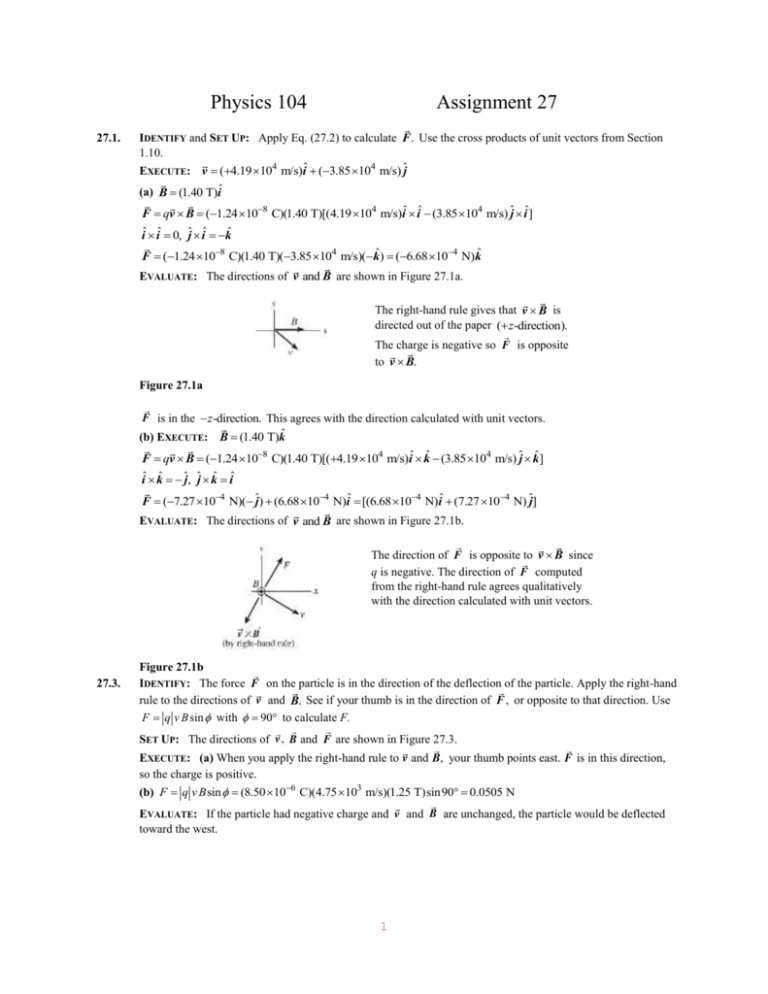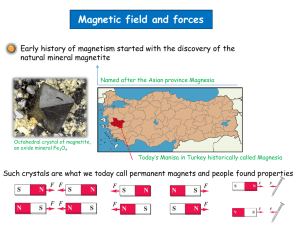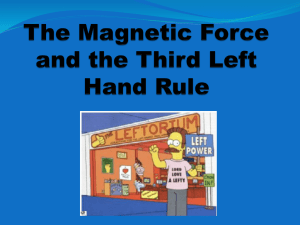posted
advertisement

Physics 104 27.1. Assignment 27 IDENTIFY and SET UP: Apply Eq. (27.2) to calculate F . Use the cross products of unit vectors from Section 1.10. EXECUTE: v (419 104 m/s)iˆ (385 104 m/s) ˆj (a) B (140 T)iˆ F qv B (124 108 C)(140 T)[(419 104 m/s)iˆ iˆ (385 104 m/s) ˆj iˆ] iˆ iˆ 0, ˆj iˆ kˆ F (124 108 C)(140 T)(385 104 m/s)(kˆ) (668 104 N)kˆ EVALUATE: The directions of v and B are shown in Figure 27.1a. The right-hand rule gives that v B is directed out of the paper ( z-direction). The charge is negative so F is opposite to v B. Figure 27.1a F is in the z-direction. This agrees with the direction calculated with unit vectors. (b) EXECUTE: B (140 T)kˆ F qv B (124 108 C)(140 T)[(419 104 m/s)iˆ kˆ (385 104 m/s) ˆj kˆ] iˆ kˆ ˆj, ˆj kˆ iˆ F (727 104 N)( ˆj) (668 104 N)iˆ [(668 104 N)iˆ (727 104 N) ˆj] EVALUATE: The directions of v and B are shown in Figure 27.1b. The direction of F is opposite to v B since q is negative. The direction of F computed from the right-hand rule agrees qualitatively with the direction calculated with unit vectors. 27.3. Figure 27.1b IDENTIFY: The force F on the particle is in the direction of the deflection of the particle. Apply the right-hand rule to the directions of v and B. See if your thumb is in the direction of F , or opposite to that direction. Use F q v B sin with 90 to calculate F. SET UP: The directions of v , B and F are shown in Figure 27.3. EXECUTE: (a) When you apply the right-hand rule to v and B, your thumb points east. F is in this direction, so the charge is positive. (b) F q v B sin (850 106 C)(475 103 m/s)(125 T)sin90 00505 N EVALUATE: If the particle had negative charge and v and B are unchanged, the particle would be deflected toward the west. 1 27.5. Figure 27.3 IDENTIFY: Apply F q v B sin and solve for v. SET UP: An electron has q 160 1019 C. F 460 1015 N 949 106 m/s 19 q B sin (16 10 C)(35 103 T)sin 60 EVALUATE: Only the component B sin of the magnetic field perpendicular to the velocity contributes to the force. 27.10.IDENTIFY: Knowing the area of a surface and the magnetic field it is in, we want to calculate the flux through it. SET UP: dA dAkˆ , so d B B dA Bz dA. EXECUTE: v EXECUTE: B Bz A (0500 T)(00340 m)2 5 78 104 T m2 . B 5.78 104 Wb. EVALUATE: Since the field is uniform over the surface, it is not necessary to integrate to find the flux. 27.11.IDENTIFY and SET UP: B B dA Circular area in the xy-plane, so A r 2 (00650 m)2 001327 m2 and dA is in the z -direction. Use Eq. (1.18) to calculate the scalar product. EXECUTE: (a) B (0230 T)kˆ; B and dA are parallel ( 0) so B dA BdA. B is constant over the circular area so B B dA BdA B dA BA (0230 T)(001327 m 2 ) 305 103 Wb (b) The directions of B and dA are shown in Figure 27.11a. B dA B cos dA with 531 Figure 27.11a B and are constant over the circular area so B B dA B cos dA B cos dA B cos A B (0230 T)cos531(001327 m2 ) 183 103 Wb. (c) The directions of B and dA are shown in Figure 27.11b. B dA 0 since dA and B are perpendicular ( 90) B B dA 0. Figure 27.11b 2 EVALUATE: Magnetic flux is a measure of how many magnetic field lines pass through the surface. It is maximum when B is perpendicular to the plane of the loop (part a) and is zero when B is parallel to the plane of the loop (part c). 27.15.(a) IDENTIFY: Apply Eq. (27.2) to relate the magnetic force F to the directions of v and B The electron has negative charge so F is opposite to the direction of v B. For motion in an arc of a circle the acceleration is toward the center of the arc so F must be in this direction. a v2/R. SET UP: As the electron moves in the semicircle, its velocity is tangent to the circular path. The direction of v0 B at a point along the path is shown in Figure 27.15. Figure 27.15 EXECUTE: For circular motion the acceleration of the electron arad is directed in toward the center of the circle. Thus the force FB exerted by the magnetic field, since it is the only force on the electron, must be radially inward. Since q is negative, FB is opposite to the direction given by the right-hand rule for v0 B. Thus B is directed into the page. Apply Newton’s second law to calculate the magnitude of B: F ma gives Frad ma FB m(v2/R) FB q v B sin q v B, so q v B m(v 2/R) B mv (9109 1031 kg)(141 106 m/s) 160 104 T qR (1602 1019 C)(0050 m) (b) IDENTIFY and SET UP: The speed of the electron as it moves along the path is constant. ( FB changes the direction of v but not its magnitude.) The time is given by the distance divided by v0 . (0050 m) 111107 s. 141106 m/s EVALUATE: The magnetic field required increases when v increases or R decreases and also depends on the mass to charge ratio of the particle. mv 27.18.IDENTIFY: Since the particle moves perpendicular to the uniform magnetic field, the radius of its path is R . qB EXECUTE: The distance along the semicircular path is R, so t R v0 The magnetic force is perpendicular to both v and B. SET UP: The alpha particle has charge q 2e 320 1019 C. (664 1027 kg)(356 103 m/s) 673 104 m 0673 mm. The alpha particle moves in (320 1019 C)(110 T) a circular arc of diameter 2R 135 mm. (b) For a very short time interval the displacement of the particle is in the direction of the velocity. The magnetic force is always perpendicular to this direction so it does no work. The work-energy theorem therefore says that the kinetic energy of the particle, and hence its speed, is constant. q v B sin (320 1019 C)(356 103 m/s)(110 T)sin 90 F 188 1012 m/s 2 . (c) The acceleration is a B m m 664 1027 kg EXECUTE: (a) R We can also use a v2 (356 103 m/s)2 and the result of part (a) to calculate a 188 1012 m/s2 , the same R 673 104 m result. 3 The acceleration is perpendicular to v and B and so is horizontal, toward the center of curvature of the particle’s path. EVALUATE: (d) The unbalanced force ( FB ) is perpendicular to v , so it changes the direction of v but not its magnitude, which is the speed. 27.21.(a) IDENTIFY and SET UP: Apply Newton’s second law, with a v 2 /R since the path of the particle is circular. EXECUTE: v F ma says q v B m(v 2 /R) q BR (1602 1019 C)(250 T)(696 103 m) 835 105 m/s 27 m 334 10 kg (b) IDENTIFY and SET UP: The speed is constant so t distance/v. R (696 103 m) 262 108 s v 835 105 m/s (c) IDENTIFY and SET UP: kinetic energy gained electric potential energy lost EXECUTE: t EXECUTE: V 1 mv 2 2 qV mv 2 (334 1027 kg)(835 105 m/s) 2 727 103 V 727 kV 2q 2(1602 1019 C) EVALUATE: The deutron has a much larger mass to charge ratio than an electron so a much larger B is required for the same v and R. The deutron has positive charge so gains kinetic energy when it goes from high potential to low potential. 27.30.IDENTIFY: For no deflection the magnetic and electric forces must be equal in magnitude and opposite in direction. SET UP: v E/B for no deflection. EXECUTE: To pass undeflected in both cases, E vB (585 103 m/s)(135 T) 7898 N/C. (a) If q 0640 109 C, the electric field direction is given by ( ˆj (kˆ )) iˆ, since it must point in the opposite direction to the magnetic force. (b) If q 0320 109 C, the electric field direction is given by (( ˆj ) (kˆ )) iˆ, since the electric force must point in the opposite direction as the magnetic force. Since the particle has negative charge, the electric force is opposite to the direction of the electric field and the magnetic force is opposite to the direction it has in part (a). EVALUATE: The same configuration of electric and magnetic fields works as a velocity selector for both positively and negatively charged particles. 27.31.IDENTIFY: For the alpha particles to emerge from the plates undeflected, the magnetic force on them must exactly cancel the electric force. The battery produces an electric field between the plates, which acts on the alpha particles. SET UP: First use energy conservation to find the speed of the alpha particles as they enter the region between the plates: qV 1/2 mv2. The electric field between the plates due to the battery is E Vbd . For the alpha particles not to be deflected, the magnetic force must cancel the electric force, so qvB qE, giving B E/v. EXECUTE: Solve for the speed of the alpha particles just as they enter the region between the plates. Their charge is 2e. v 2(2e)V 4(160 1019 C)(1750V) 411 105 m/s m 664 1027 kg The electric field between the plates, produced by the battery, is E Vb /d (150 V)/(0.00820 m) 18,300 V/m The magnetic force must cancel the electric force: B E/v (18,300 V/m)/(4.11105 m/s) 0.0445 T The magnetic field is perpendicular to the electric field. If the charges are moving to the right and the electric field points upward, the magnetic field is out of the page. EVALUATE: The sign of the charge of the alpha particle does not enter the problem, so negative charges of the same magnitude would also not be deflected. 4 27.38.IDENTIFY: Apply F IlB sin . SET UP: l 00500 m is the length of wire in the magnetic field. Since the wire is perpendicular to B, 90. EXECUTE: F IlB (108 A)(00500 m)(0550 T) 0 297 N EVALUATE: The force per unit length of wire is proportional to both B and I. 27.42.IDENTIFY: The magnetic force FB must be upward and equal to mg. The direction of FB is determined by the direction of I in the circuit. V SET UP: FB IlB sin , with 90. I , where V is the battery voltage. R EXECUTE: (a) The forces are shown in Figure 27.42. The current I in the bar must be to the right to produce FB upward. To produce current in this direction, point a must be the positive terminal of the battery. (b) FB mg. IlB mg. m IlB VlB (175 V)(0600 m)(150 T) 321 kg. g Rg (500)(980 m/s2 ) EVALUATE: If the battery had opposite polarity, with point a as the negative terminal, then the current would be clockwise and the magnetic force would be downward. Figure 27.42 27.46.IDENTIFY: IAB sin , where is the angle between B and the normal to the loop. SET UP: The coil as viewed along the axis of rotation is shown in Figure 27.46a for its original position and in Figure 27.46b after it has rotated 300. EXECUTE: (a) The forces on each side of the coil are shown in Figure 27.46a. F1 F2 0 and F3 F4 0. The net force on the coil is zero. 0 and sin 0, so 0. The forces on the coil produce no torque. (b) The net force is still zero. 30.0 and the net torque is (1)(140 A)(0220 m)(0350 m)(150 T)sin300 00808 N m. The net torque is clockwise in Figure 27.46b and is directed so as to increase the angle . EVALUATE: For any current loop in a uniform magnetic field the net force on the loop is zero. The torque on the loop depends on the orientation of the plane of the loop relative to the magnetic field direction. Figure 27.46 27.48.IDENTIFY: B and U B cos , where NIB. B sin . SET UP: is the angle between B and the normal to the plane of the loop. EXECUTE: (a) 90. NIABsin(90) NIAB, direction kˆ ˆj iˆ. U B cos 0. (b) 0. NIABsin(0) 0, no direction. U Bcos NIAB. (c) 90. NIAB sin(90) NIAB, direction kˆ ˆj iˆ. U B cos 0. 5 (d) 180: NIAB sin(180) 0, no direction, U B cos(180) NIAB. EVALUATE: When is maximum, U 0. When U is maximum, 0. 27.49.IDENTIFY and SET UP: The potential energy is given by Eq. (27.27): U B. The scalar product depends on the angle between and B. EXECUTE: For and B parallel, 0 and B B cos B. For and B antiparallel, 180 and B B cos B. U1 B, U 2 B U U2 U1 2 B 2(145 A m2 )(0835 T) 242 J EVALUATE: U is maximum when and B are antiparallel and minimum when they are parallel. When the coil is rotated as specified its magnetic potential energy decreases. 6








